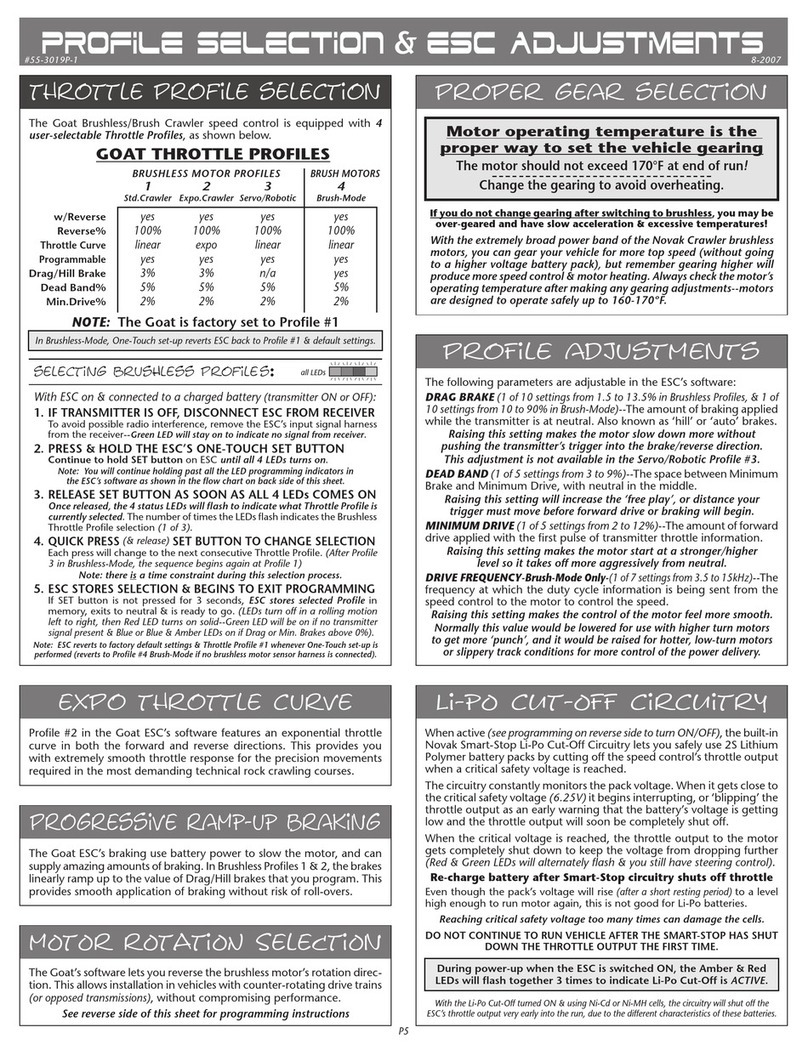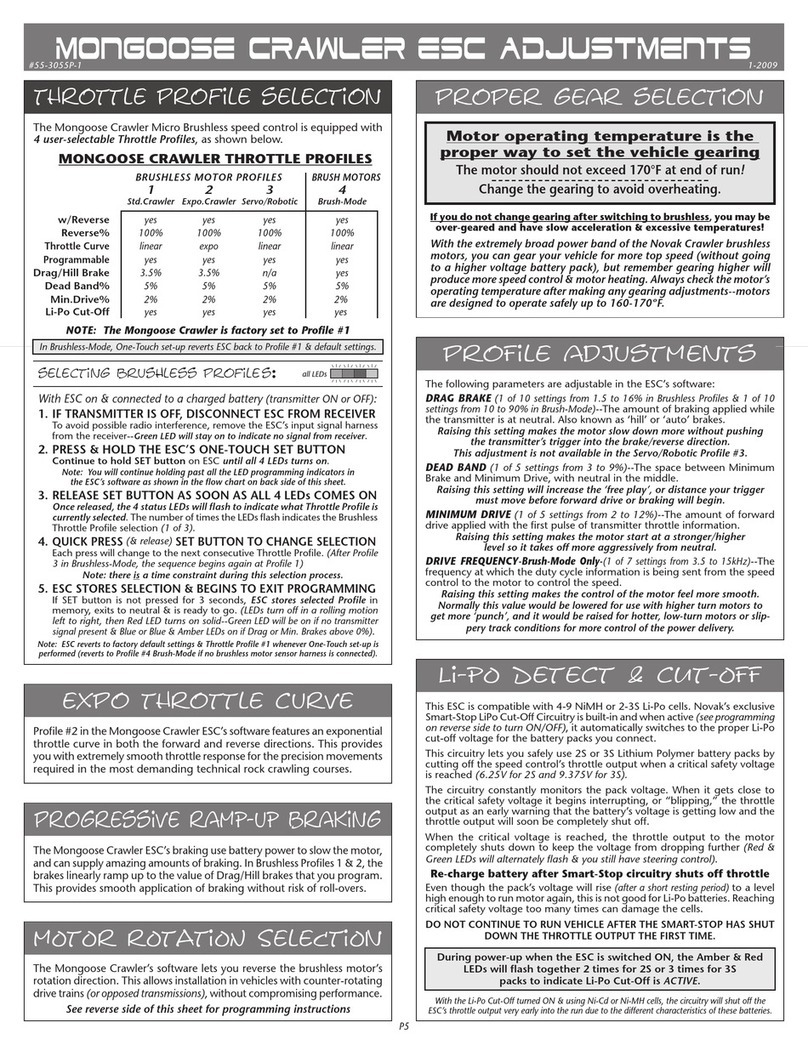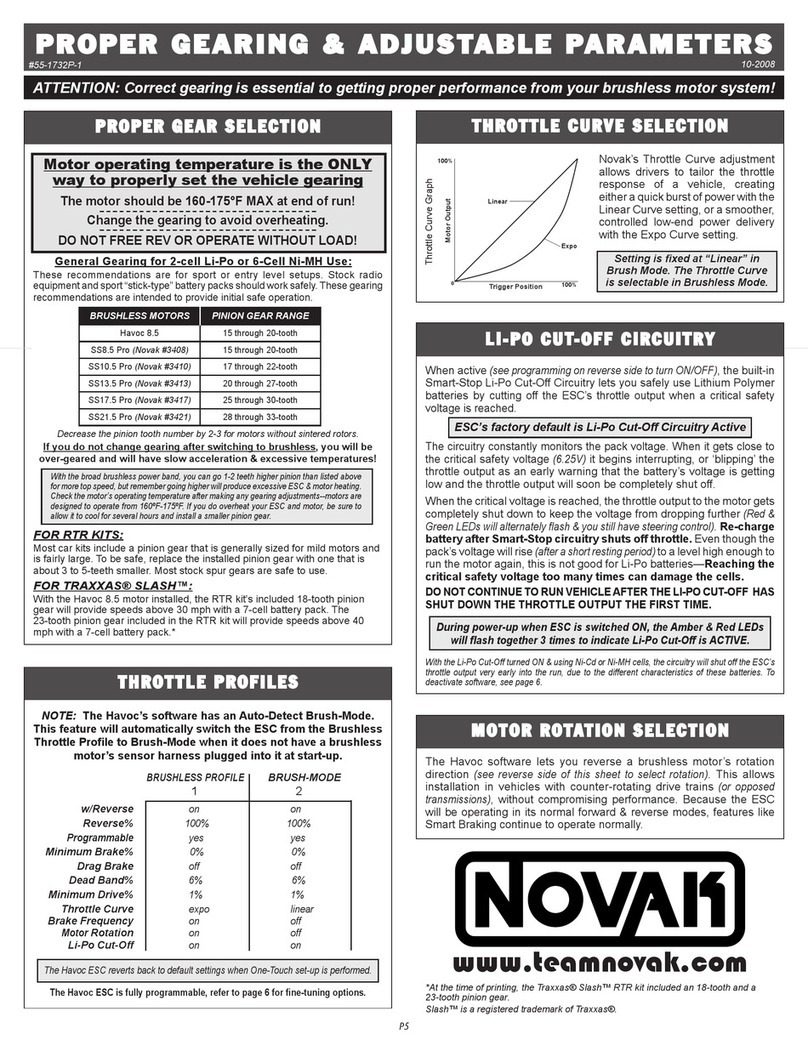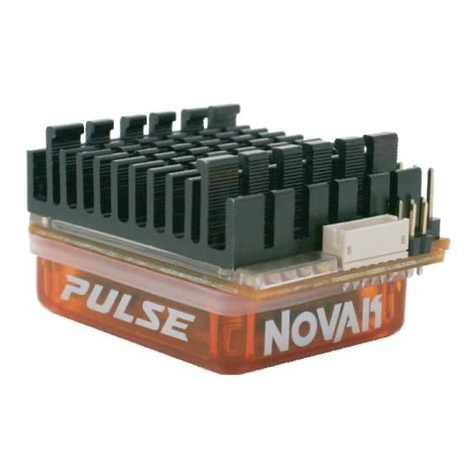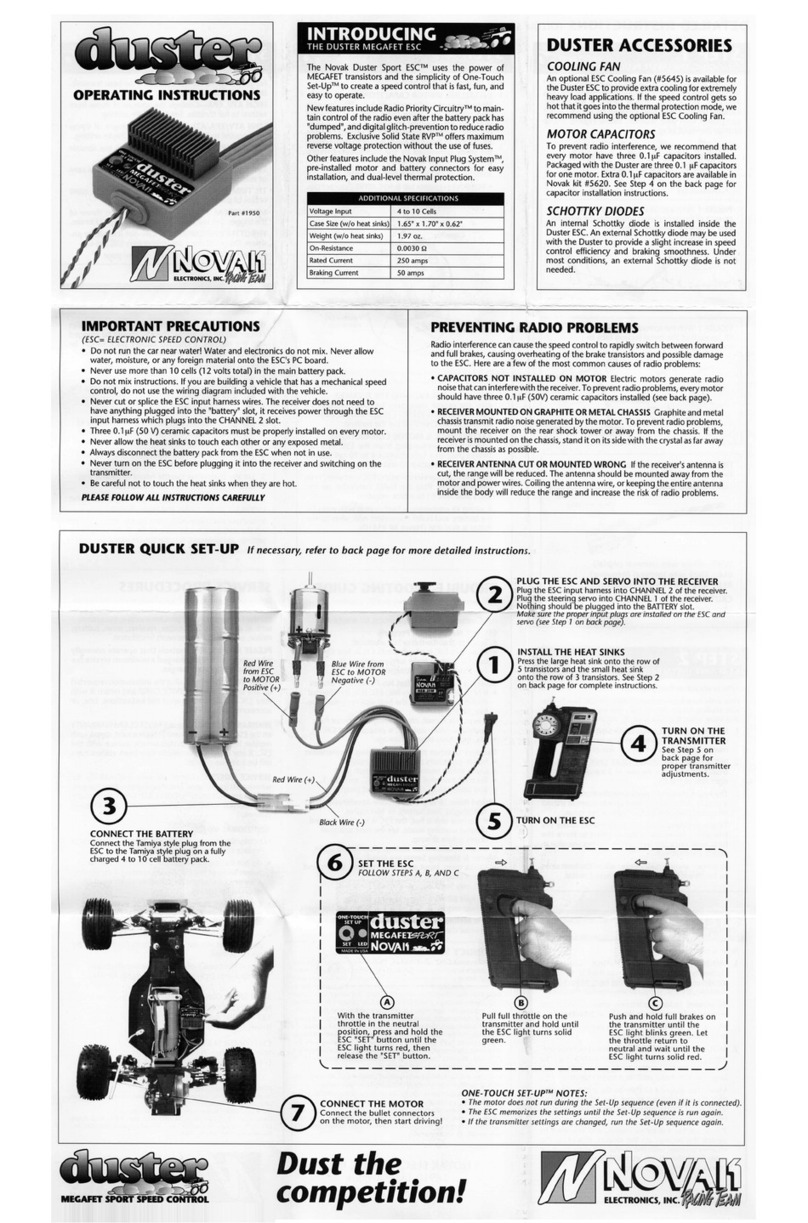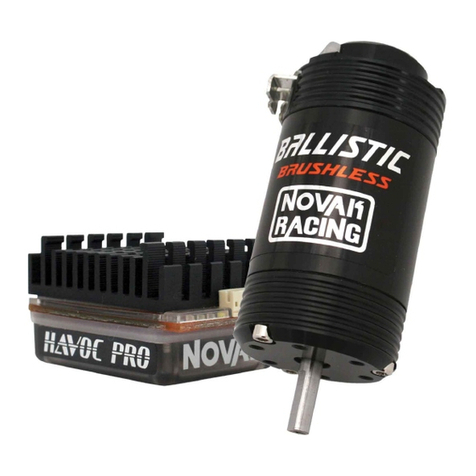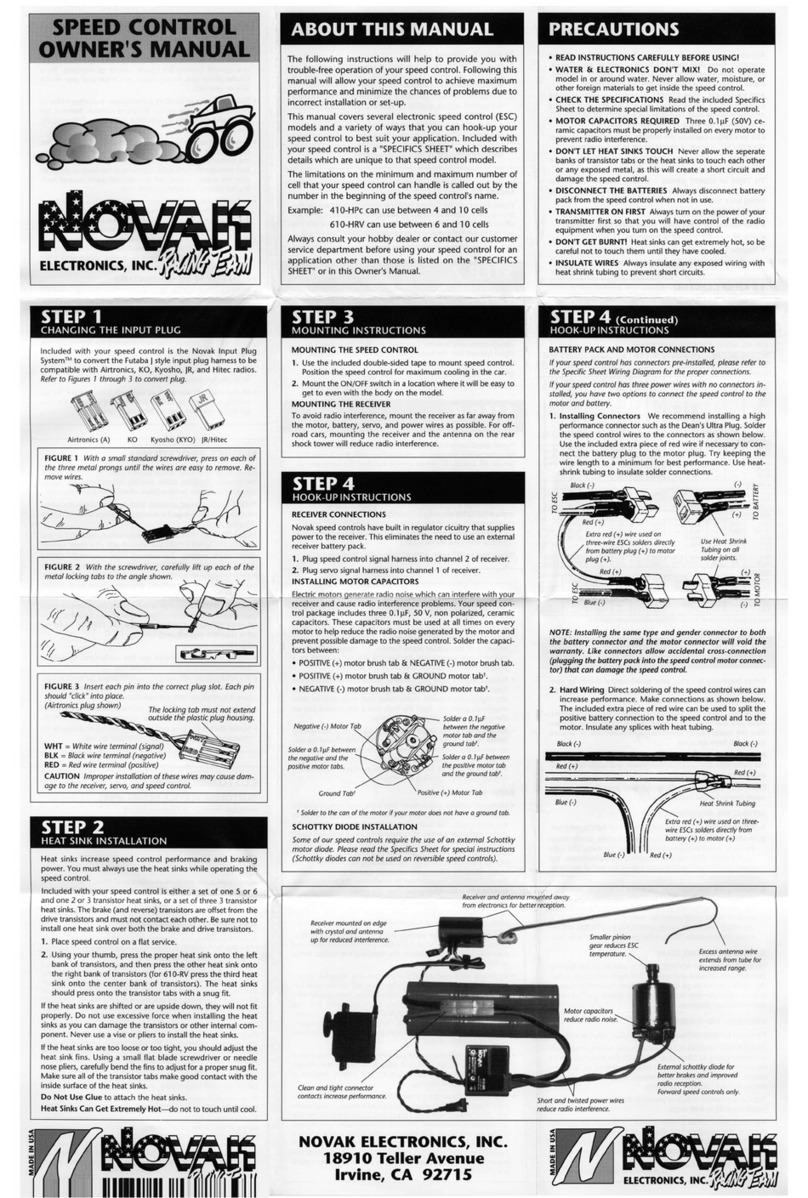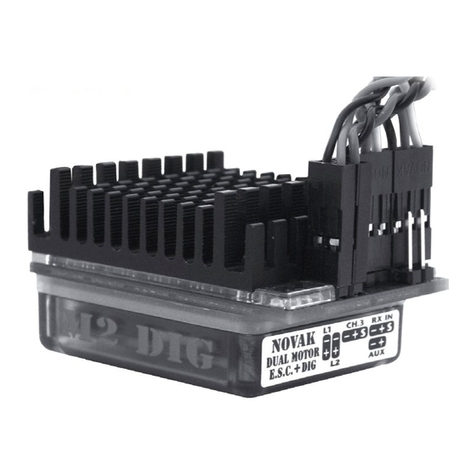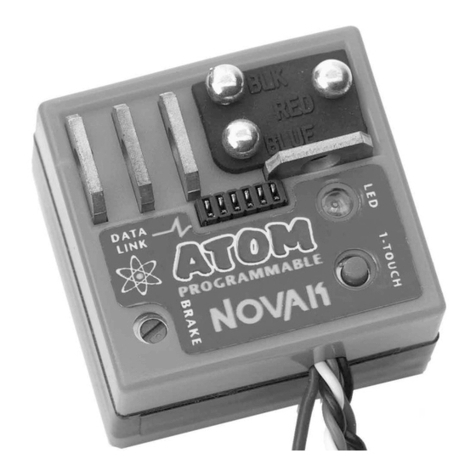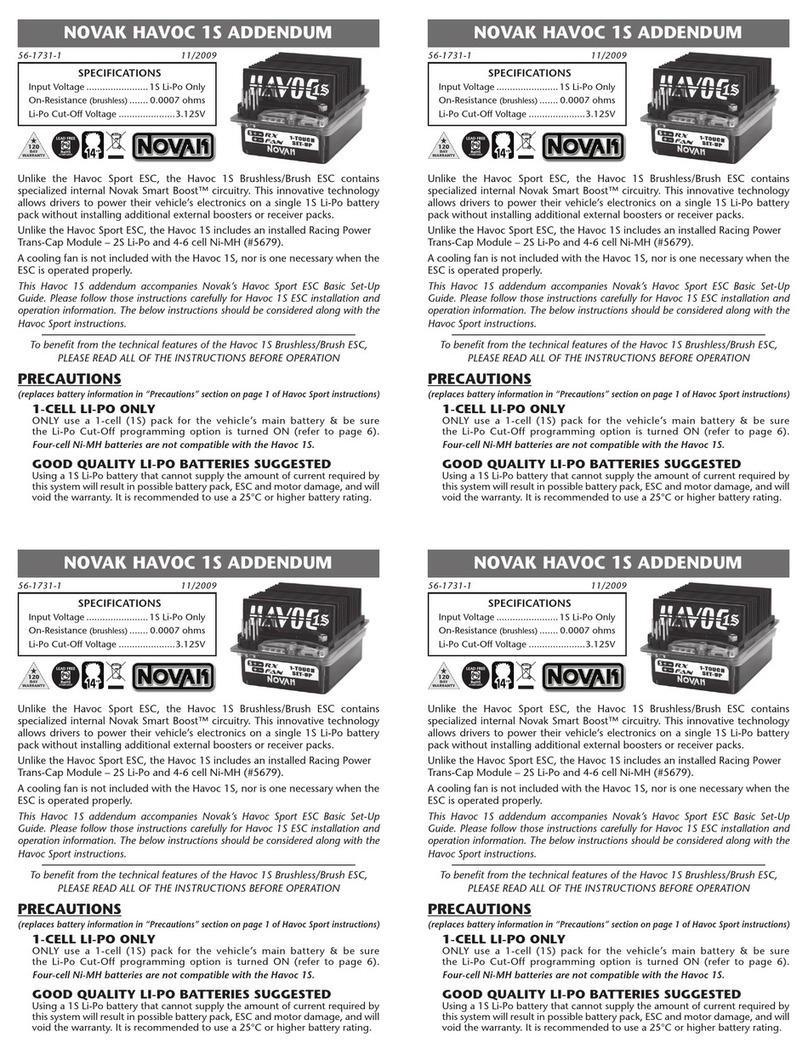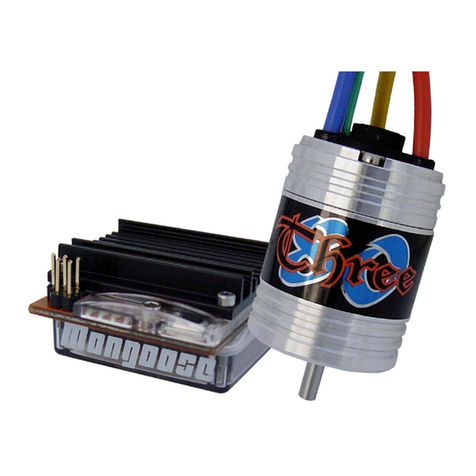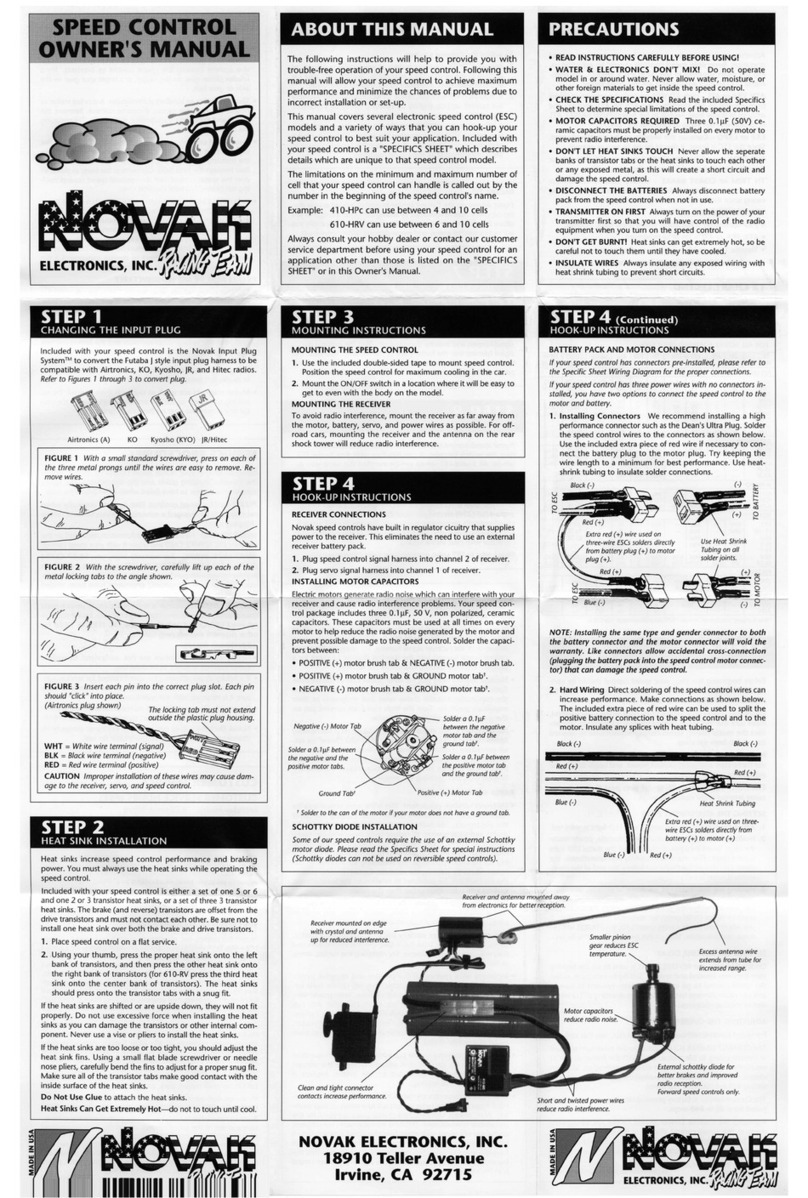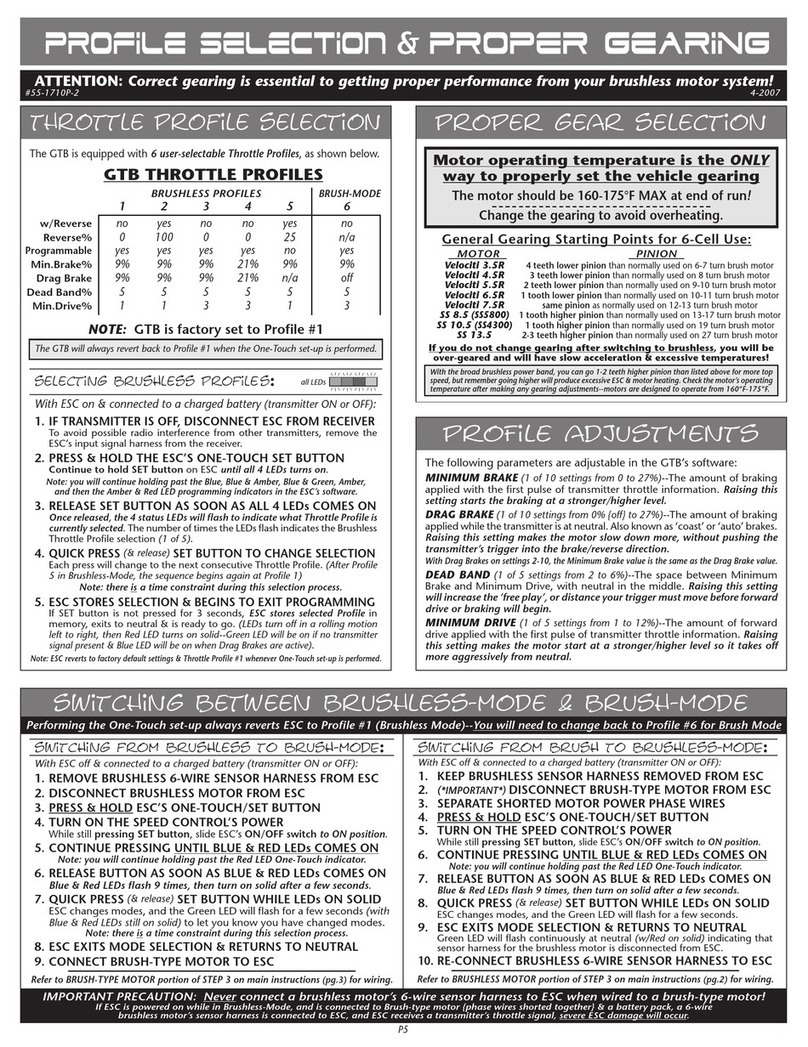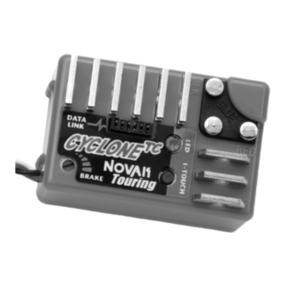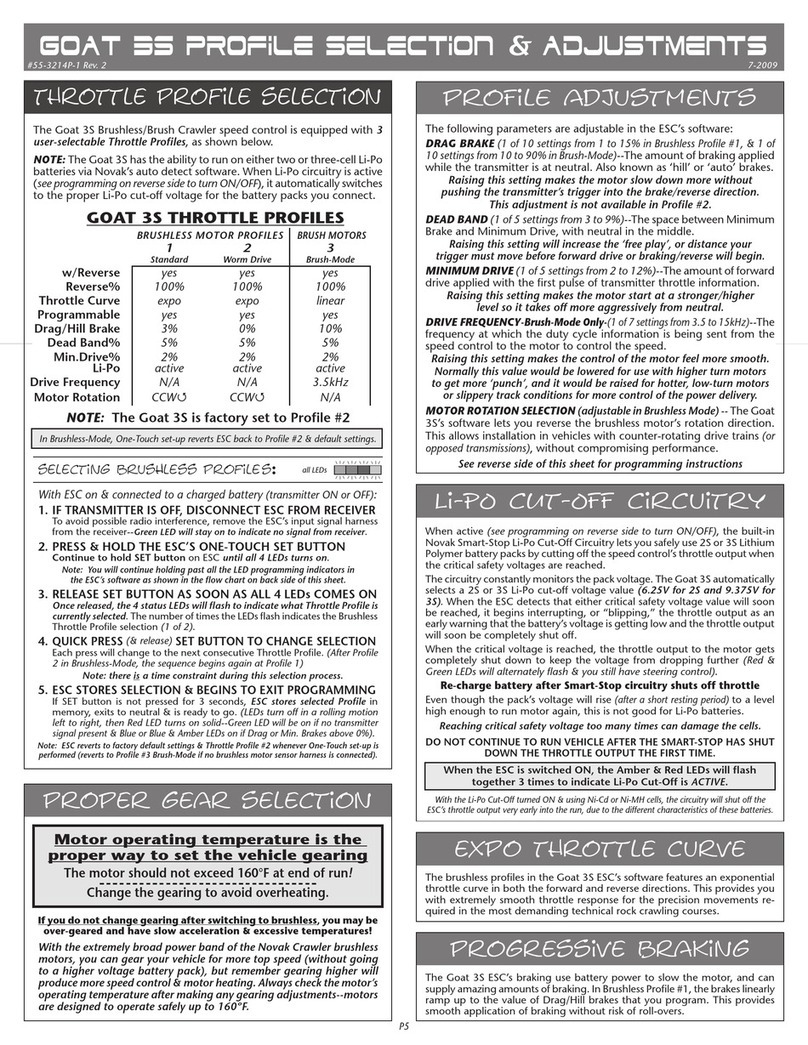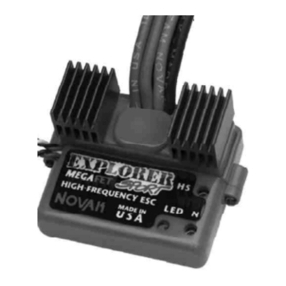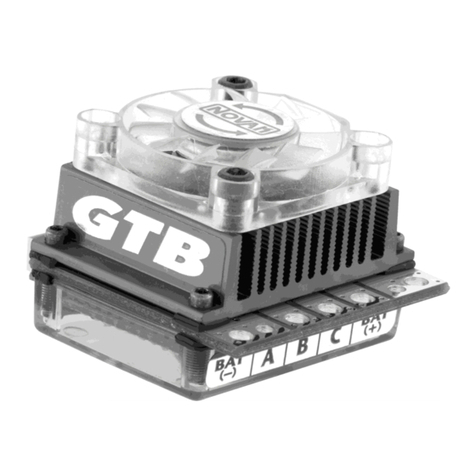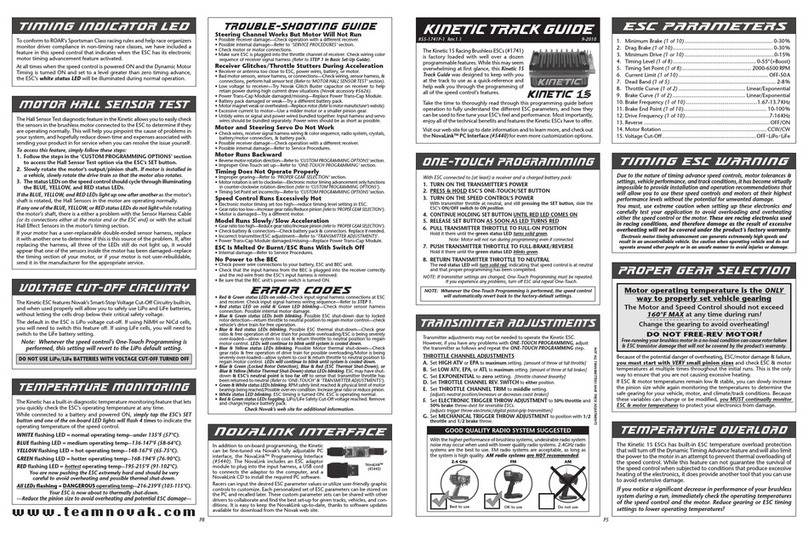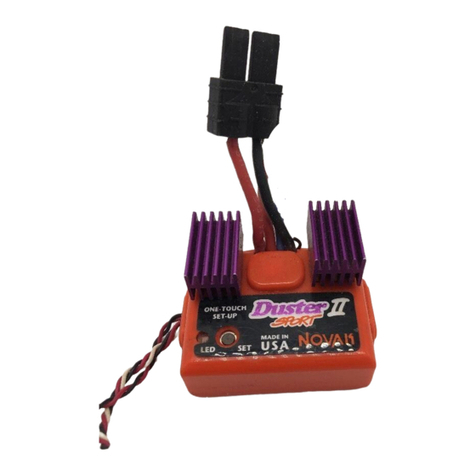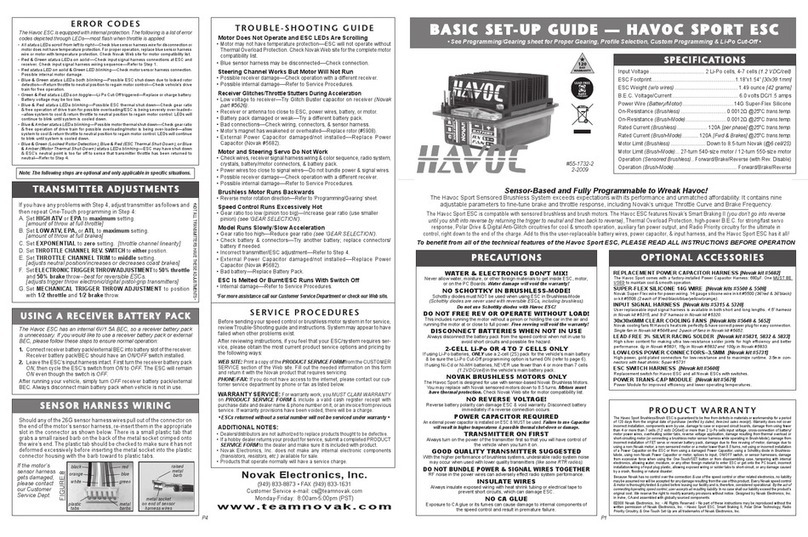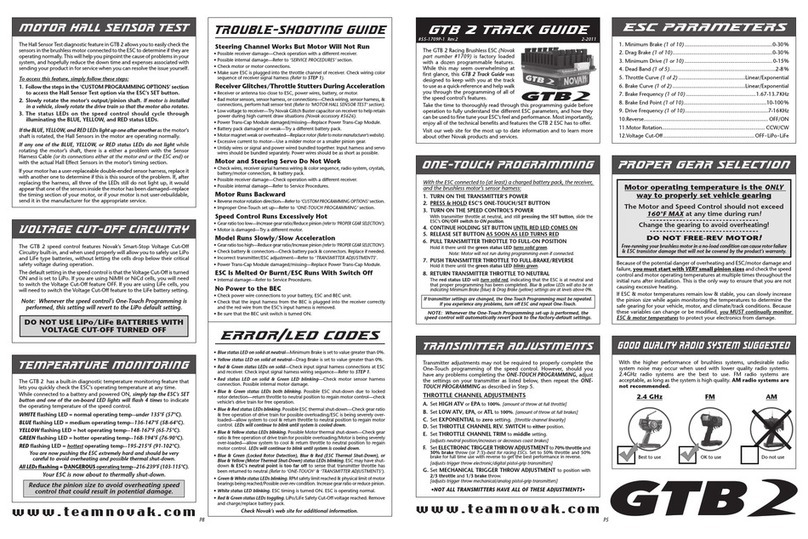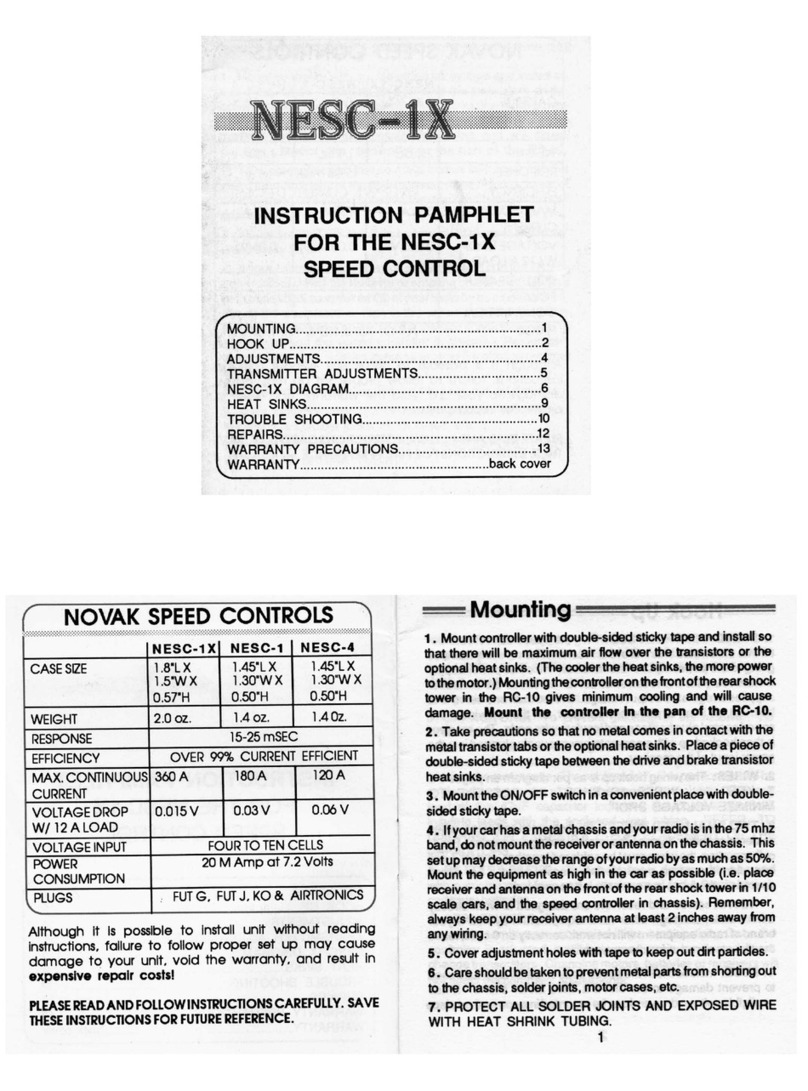SET-UP PHOTO
STEP 4
TRANSMITTER ADJUSTMENTS
For proper ESC operation adjust transmitter as follows:
1. Set HIGH ATV or EPA to maximum setting.
[Controls amount of throw from neutral to full throttle]
2. Set LOW ATV, EPA, or ATL to maximum setting.
[Controls amount of throw from neutral to full brakes]
[Reducethis after programmingto reduce amountofbrakes]
3. Set EXPONENTIAL to zero.
[Controls the linearity of the throttle channel]
4. Set THROTTLE CHANNEL TRIM to middle setting.
[Adjustsneutral position/Increases or decreasescoast brakes]
5.
SetCHANNEL REVERSING SWITCH to either position.
6. Set ELECTRONIC TRIGGER THROW ADJUSTMENT
to 70% throttle and 30% brake throw (or 7:3).
[Adjusts pistol-grip transmitter’s throttle trigger throw]
7. Set MECHANICAL TRIGGER THROW ADJUSTMENT
to position with 2/3 throttle and 1/3 brake throw.
[Adjusts pistol-grip transmitter’s throttle trigger throw]
Before beginning this step, the speed control should be
connected to the receiver and to a charged 4 to 7 cell
battery pack, and the transmitter should be adjusted.
1. CONNECT THE BATTERY
2.
TURN ON TRANSMITTER THEN THE SPEED CONTROL
Press and release the One-Touch/ON-OFF button.
Note: Status LED may or may not come on if ESC and
transmitter nuetral positions are not the same.
NOTE: To turn the ESC on & off, just press and release the
button
as you would the numbers on a touch-tone phone or
keyboard––just a quick/momentary press of the button.
3.
PRESS & HOLD ESC’S ONE-TOUCH/ON-OFF BUTTON
With the transmitter throttle in the neutral position,
press and hold the One-Touch/ON-OFF button on the
speed control until the status LED turns solid red.
4. RELEASE ESC’S ONE-TOUCH/ON-OFF BUTTON
5. PULL THROTTLE TO FULL-FORWARD POSITION
Hold it there until the status LED turns solid green.
NOTE: The motor will not run during programming even
if it is connected to the speed control.
6. PUSH THROTTLE TO FULL-BRAKE POSITION
Hold it there until the status LED blinks green.
7. RETURN TRANSMITTER THROTTLE TO NEUTRAL
The status LED will turn solid red, indicating that the
throttle is in the neutral position and also that proper
programming has been completed.
The speed control is programmed and ready to race!
If transmitter settings are changed, it will be necessary
to complete the programming sequence once again.
If you experience any problems during programming,
turn off the speed control and repeat programming.
RECEIVER BATTERY PACK
The CycloneC2 and CycloneTC2 speed controls should not
require an external receiver battery pack for most racing situ-
ations.
The built-in Radio-Priority Circuity™ provides complete
control
of the steering servos even after the main battery pack
has ‘dumped’ and can no longer provide the power required
to turn the motor. However, applications with multiple high-
power servos, and some 4-cell set-ups may require an external
receiverbattery pack toprevent overloading or underpowering
of the speed control’s voltage regulator.
1. Remove the red wire from the speed control’s
input signal
harness as described in Figure 3. E
ither end of the red wire
can be removed from the harness. Insulate the exposed
end
of the wire/metal socket that you remove from the plug plastic.
2. Plug the external 5 cell (1.2V/cell) receiver battery pack
into the battery slot of the receiver.
3. Use the ON-OFF switch on the external receiver battery
pack to turn the receiver’s power on and off.
4. Use the speed control’s ONE-TOUCH/ON-OFF button to
turn the speed control’s power on and off.
TROUBLE-SHOOTING GUIDE
This section describes possible speed control problems,
causes, and solutions.
Steering Channel Works But Motor Will Not Run
• Check motor connections. Check motor and brushes.
• Make sure input signal harness is plugged into the
throttle channel of receiver and the speed control.
Check throttle channel operation with a servo. Check
wiring color sequence of receiver signal harness.
• Possible internal damage––Refer to Service Procedures.
Receiver Glitches/Throttle Stutters During Acceleration
• Receiver or antenna too close to speed control, power
wires, battery, or motor––Refer to Step 2.
• Bad connections––Check wiring and connectors.
• Motor brushes worn––Replace brushes.
• Excessive current to motor––Use a milder motor or a
smaller pinion gear.
•
External Power Capacitor damaged/not installed––Refer
to Step 3/replace Power Capacitor
(possible internal damage)
.
Motor and Steering Servo Do Not Work
• Check wires, receiver signal harness wiring and color
sequence, radio system, crystals, battery and motor
connectors, and battery pack.
• Possible internal damage––Refer to Service Procedures.
Model Runs Slowly / Slow Acceleration
•
Checkmotor andbatteryconnectors––Replace if needed.
• Bad battery or motor––Check operation with another.
•
Incorrect transmitter or speed control adjustment––Refer
to Steps 4 and 5.
•
External Power Capacitor damaged/not installed––Refer
to Step 3/replace Power Capacitor
(possible internal damage)
.
• Optional external Schottky diode installed backwards
or damaged––Refer to Step 3.
Motor Runs Backwards
• Motor wired backwards––Check wiring and reverse.
• Backwards motor timing––Reverse motor end bell.
ESC Is Melted Or Burnt/ESC Runs With Switch Off
• Internal damage––Refer to Service Procedures.
*For more help call our Customer Service Department.
SERVICE PROCEDURES
Before sending your CycloneC2/CycloneTC2 for service,
review
the Trouble-Shooting guide and instructions. The
ESC may appear to have failed when other problems exist.
After reviewing the instructions, if you feel that your ESC
requires service, please obtain the most current product
service options and pricing by one of the following methods:
WEBSITE: We have an abundance of information available
for all levels of speed controls, and all of our products.
Print a copy of the PRODUCT SERVICE FORM from the
SERVICE section of the website. Fill out the needed infor-
mation on this form and return it with the Novak product
that requires servicing.
PHONE/FAX/E-MAIL: If you do not have access to the
internet, contact our customer service department by
phone, fax, or e-mail as listed in the CUSTOMER SERVICE
section below, and they will supply you with current service
options and send you a PRODUCT SERVICE FORM.
WARRANTY SERVICE:
Forwarranty work,youMUST CLAIM
WARRANTY on the PRODUCT SERVICE FORM and include
a valid cash register receipt with purchase date on it, or an
invoice from previous service work. If warranty provisions
have been voided there will be service charges.
ADDITIONAL NOTES:
•
Hobby dealers or distributors are not authorized to
replace Novak products thought to be defective.
• If a hobby dealer returns your speed control for service,
submit a completed PRODUCT SERVICE FORM to the
dealer and make sure it is included with the speed control.
•
Novak Electronics, Inc. does not make any electronic
components (transistors, resistors, etc.) available for sale.
PRODUCT WARRANTY
The CycloneC2/CycloneTC2 is guaranteed to be free from defects
in
materials or workmanship for a period of 120 days from original
date of purchase
(verified by dated, itemized sales receipt)
. Warranty
does not cover incorrect installation, components worn by use,
damage
from using fewer than 4 or more than 7 cells
(1.2 volts DC/
cell)
input voltage, short-circuiting heat sinks, cross-connection of
battery/motor, overheating & desoldering solder posts, reverse volt-
age application, damage resulting from thermal overload, damage
from incorrect installation of FET servo
or receiver battery pack, dam-
age from excessive force while installing heat sinks, not installing or
incorret installation of
a Novak power capacitor
on the ESC, splices
to input harness, damage from excessive
force when using the One-
Touch/ON-OFF
button or BRAKE pot
or from disassembling case,
tampering with internal electronics,
allowing water, moisture, or
any other foreign material to enter
ESC
or get
onto the PC board,
incorrect installation/wiring of input plug plastic,
allowing exposed
wiringorsolderpoststoshort-circuit, or anydamage
causedbyacrash,
flooding, or act of God.
In no case shall our liability exceed product's original cost. We reserve
the right to modify warranty provisions without notice.
Because Novak Electronics, Inc. has no control over the connection
and use of the speed control, no liability may be assumed nor will
be accepted for damage resulting from the use of this product. Every
ESC is thoroughly tested and cycled before leaving our facility and
is, therefore, considered operational. By the act of connecting/operating
ESC, the user accepts all resulting liability.
CUSTOMER SERVICE
CUSTOMER SERVICE HOURS (PST)
Monday-Thursday: 8:00am-5:00pm
Friday: 8:00am-4:00pm
(closedeveryotherFri.)
(949) 833-8873 • FAX (949) 833-1631
©2001 Novak Electronics, Inc. • All Rights Reserved
No part of these operating instructions may be reproduced without the
written permission of Novak Electronics, Inc.
All Novak speed controls are designed and manufactured in the U.S.A.
CycloneC2™, CycloneTC2™, HYPERFET III™, Polar Drive™, One-Touch
Set-Up™, Radio Priority Circuitry™, and Digital Anti-Glitch Circuitry™
are all trademarks of Novak Electronics, Inc.
Printed in the U.S.A. 4/2001 • #IM-1775-2
STEP 7
MINIMUM BRAKE ADJUSTMENT
The BRAKE pot on the CycloneC2 and CycloneTC2 allows you
to adjust the percentage of total braking power applied with
the initial trigger movement in the brake direction. Refer to
above illustration for indication of Minimum Brake Value.
•
Turning BRAKE pot clockwise,increases amount of minimum
brakingup toa maximumof 75%of thetotal brakeforce.
• Turning BRAKE pot all the way counter-clockwise, sets
the amount of minimum braking at the lowest value of
0.39%, or 1/256th (one step) of the total brake force.
STEP 5
SPEED CONTROL PROGRAMMING
STEP 6
THROTTLE PROFILE SELECTION
FET SERVO CONNECTION
The CycloneC2 and CycloneTC2 speed controls are not wired
for connecting a FET servo. The fourth wire from the servo
must be wired directly to the main battery pack.
Be sure to install the 10µH inductor (supplied with servo) in
series with the FET servo’s fourth wire as shown below.
Remember that the servo will be powered ON as long as it is
connected to the battery pack!
NOVAK ELECTRONICS, INC.
18910 Teller Avenue
Irvine, CA 92612
www.teamnovak.com
Combination
ON-OFF switch
&
One-Touch Button
Keep receiver
and antenna
away from
motor, servo,
battery, and
power wires.
Red wire
(battery &
motor positive)
Tip: Twist motor
wires to reduce
radio noise!
Trail excess wire
off antenna mast.
(Do not cut or coil)
Blue wire
(motor negative)
Black wire
(battery negative)
(–)
(–)
(+)
(+)
TheCycloneC2 and CycloneTC2allow you tochoose between
three user-selectable throttle profiles that are programmed at
the factory. This chart gives the specifics of each profile:
% kHz % kHz
1**Modified 5.0 15.60 2.0 3.90 OFF
2 Stock 5.0 5.86 6.0 3.90 OFF
3 Drag Brake 5.0 7.80 4.0 5.86 ON
1 **World Cup 5.0 15.60 2.0 3.90 OFF
2 High Traction 3.0 11.70 3.0 5.86 OFF
3 Touring Stock 3.0 7.80 5.0 11.70 OFF
Experiment with each profile to determine which works best for you!
1. TURN ON THE TRANSMITTER
2. TURN ON THE SPEED CONTROL
3.
PRESS & HOLD ESC’S ONE-TOUCH/ON-OFFBUTTON
until
the status LED turns solid green. The LED will first turn red,
then a few seconds later it will turn green.
4.
RELEASE ONE-TOUCH/ON-OFF BUTTON and then the
status LED will begin to blink red. The number of times the
LED blinks indicates the profile number selected.
5.
PRESS & RELEASE ONE-TOUCH/ON-OFF BUTTON TO SELECT
Each press will change to the next consecutive profile number.
NOTE: After profile #3, the sequence begins again at profile #1.
6.
If ONE-TOUCH/ON-OFFbutton is notpushed for fiveseconds
,
the ESC LOADS THE SELECTED PROFILE INTO MEMORY,
and the status LED turns solid red,indicatingthat the speed
control has exited the profile selection mode and is in neutral.
CUSTOM FOURTH PROFILE
Both speed controls can store a custom fourth profile that is created
withtheoptionalprogrammingdevice,thePit Wizard (#1035).Once
a custom profile has been created and downloaded into the ESC,
there will be four profiles to choose from. The Pit Wizard comes with
complete details on creating your own custom profiles and gives you
the ability to modify the following parameters: Neutral
Postion, Full
Throttle Position, Full Brake Position, Dead Band Value, Drag Brake
Value,Drag Brake Frequency*, Drive PWM Frequency*, Minimu
mDrive
Value, Brake PWM Frequency*, and the Drag Brake Toggle.
*Adjustable from 122-23,400 Hz
Illustration below shows graphical display of adjustable parameters
Profile
Description
Dead Band
Drive Frequency
Minimum Drive
Brake Frequency
Dr.Brake Toggle
C2TC2
(**default)
Fourth wire
from servo.
10
µ
H inductor
To main
battery pack
Input Signal
Harness
(user-replaceable)
4-7 cell
battery pack
Brake
Adjust
Pot
Status
LED
Pit Wizard
DataLink
Shottky
diode
Power
Capacitor
PowerCap
Harness
